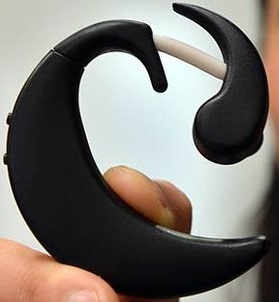Researchers in Japan are now testing a very small computer that can fit into the human ear.
As wearable technology explodes, particularly in the form of smartwatches, researchers in Japan are taking things a step further and are developing a tiny personal computer that a user can wear in his or her ear.
Users would control this device with a click of the tongue or a blink of the eye.
This wearable technology weighs only 17 grams and is completely wireless. It uses Bluetooth to connect with other devices and is equipped with a battery, speaker, microphone, compass, GPS, barometer, and gyro-sensor. Computing in the form of wearables is believed to be the latest thing in tech, but this latest development is easily among the smallest and most hands-free that has made its way to the headlines.
Other forms of wearable technology are notably larger, such as Google Glass, and Samsung Galaxy Gear 2.
This particular wearable technology for the ear is being called the “Earclip-type Wearable PC”, for the moment. It has microchip and data storage, which gives users the ability to load software. This, according to Kazuhiro Taniguchi, an engineer at the Hiroshima City University. The designs for the device are based on the traditional Japanese flower arrangements known as “ikebana”.
Taniguchi explained that the team of mobile developers created the device so that people would be able to think of wearing it in the same way that they would think about wearing earrings. The prototype for the gadget was demonstrated in black and had an overall comparable look to the sports style earbuds that wrap around the ear, or a single ear telephone headset.
The researchers are working to have this wearable technology ready by the holiday shopping season in 2015. At that time, users will be able to connect the device to their mobile devices such as an iPod or other gadgets that allow the user to navigate through various apps. All the user will need to do is change his or her facial expression, such as through a nose wiggle, a tongue movement, a raised brow, or even clenched teeth. Within the device inside the ear, infrared sensors detect the facial movements and respond accordingly.
The credit card giant will be working with Syniverse on this location based verification checking.
With the explosion in the number of smartphone users that there are around the world, MasterCard is working to capitalize on these consumers – particularly those travelling internationally – and to encourage them to use their services without the risk of losing time, patience, and money to security problems, by using geolocation technology for verification.
A new security system is now being implemented to confirm credit card payments through customer smartphones.
This is not an entirely revolutionary process, but instead uses geolocation technology as a variation of the current standard two step process of authentication. However, instead of requiring the smartphone user to enter an additional login code, as is the case with certain web services, the proposal of MasterCard is to use the GPS function from mobile devices, which has become a standard function in most smartphones.
The idea is to use geolocation technology to show that the card and user are in the same place.
What this means is that if the smartphone of the credit card user is located in the same place as the card when it is being used, then the transaction receives approval. MasterCard has said that this helps to shrink the chance of both unauthorized attempts to use the card and of declined transactions that are actually valid.
The one problem that has been identified that could cause a considerable problem to this mobile security system is that when users travel internationally, the odds are that they will have shut off their data service in order to help to reduce the chance of building up expensive roaming charges. This would eliminate the benefit of the concept behind MasterCard’s validation service.
MasterCard has not failed to recognize this issue. The company is, therefore, working to offer prepaid data packages that can be purchased directly through their own mobile devices from the moment that they arrive in another country. This is meant to help to encourage users to keep their data connection enabled so that they will be able to use the added security based on geolocation technology.



